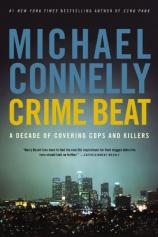Crime Beat: A Decade of Covering Cops And Killers
Review
Crime Beat: A Decade of Covering Cops And Killers
In a little over a decade, Michael Connelly has established himself
as one of the best mystery writers working in America today.
With novels like THE BLACK ECHO and THE CONCRETE BLONDE, he brought
readers onto the mean streets of modern Los Angeles through cases
involving police detective Harry (short for Hieronymus) Bosch. His
fifth novel and first non-Bosch book, THE POET, made Connelly a
bestselling author. He has written a total of 16 mysteries and
crime novels.
CRIME BEAT is Connelly's first book of nonfiction and a compilation
of his writings as a newspaper crime reporter in both Florida and
Los Angeles from 1984 to 1992. These 22 articles display the raw
material that in Connelly's skilled hands would later help produce
Harry Bosch and the serial killer known as the Poet. They also
reveal the attention to detail and clean, concise writing that is a
hallmark of both great journalism and Connelly's novels.
And in many ways, these works of nonfiction are even darker and
more terrifying than his novels. In the introduction of CRIME BEAT,
Connelly writes, "The irony of crime beat journalism --- maybe all
journalism --- is that the best stories are really the worse
stories. The stories of calamity and tragedy are the stories that
journalists live for. It gets the adrenaline churning in their
blood and can burn them out young, but nevertheless it is a hard
fact of the business. Their best day is your worse day."
And there are a lot of bad days in CRIME BEAT. A hit man kills his
target with a machine gun in front of the victim's 16-year-old son.
A husband hires somebody to beat his wife to death in her bed as
she recovers from a mastectomy. A nurse sees a man lying in the
street, stops her car to help him, and the man jumps up and shoots
her dead. A serial killer poses as a professional photographer to
lure young women to their deaths.
The violence chronicled here is grim, unrelenting and executed for
all the usual reasons: greed, sex, rage, power and madness. And
worst of all, it is real.
Readers turn to mysteries for entertainment; reading the darkest
story is like listening to a ghost story around the campfire. We
want to be scared but know that by the time the last embers die, we
will be safe in our sleeping bags as we drift off to sleep and dawn
is on the way. And with that dawn and on the last page, justice
will prevail.
Reporters and cops know that this is rarely the case in real life.
Happy endings happen only in movies. The killer sometimes is caught
and sometimes disappears, like the 21-year-old son who meticulously
planed and executed the murder of his father in Los Angeles in 1987
and was never found. Or sometimes, the case is never solved, like
the murder of the 51-year-old businessman, Vic Weiss, who was found
stuffed in the trunk of his red and white Rolls Royce in LA in
1988. That news story later became the basis for Connelly's novel,
TRUNK MUSIC.
What makes CRIME BEAT so hard-boiled is the simple, understated way
Connelly writes about these horrors. For example, he says:
"Michael Connable, 31, was walking with two friends down Sixth
Street towards the Riverside Pub. It was midnight dark, and a
second group of three men were approaching from the opposite way.
As the two groups passed, one of the men from Group Two opened
fire. The men from Group One began running. Fifty yards later
Connable fell dead a few feet from the door to the Riverside Pub,
his blood slowly seeping down an incline on the parking lot towards
a storm drain."
In the world Connelly writes about, violence strikes without
warning and the results last forever. A woman seeks to escape her
con man husband when she finds that he is married to another woman
and has lived a double life. She gets the husband to surrender his
gun to police. What she doesn't find out until the moment before he
kills her is that the police gave the gun back to him.
"She would have never gone there if she knew he had the gun back,"
he (the victim's attorney) said. "She made a mistake and paid for
it."
Connelly is not only a great novelist; CRIME BEAT proves that he is
also a great reporter. Another great reporter turned great
novelist, Pete Hamill, once told me that the tough thing about
working the crime beat for a newspaper is that you can't approach
it like a cop or funeral home director seeing yet another body
during another day of work. You have to make death seem fresh each
and every time you write a story because even if it is your 1,000th
murder scene, the reader is reading it for the first time.
Connelly accomplishes this in CRIME BEAT. He doesn't editorialize.
His stories are filled with the detachment and telling details of
the reporter. But beneath the surface, you can feel the empathy he
has for the victims and get a sense of the complexity that would
later emerge in his fictional characters, like Harry Bosch. Good
and evil is not always as simple as black and white.
It is the work of the novelist to explore those complexities and
the gray areas that exist inside the human heart. Michael Connelly
will be doing this for years to come, much to the delight of
mystery fans. Read CRIME BEAT and see a young writer laying the
foundation for his lifework.
Reviewed by Tom Callahan on December 28, 2010
Crime Beat: A Decade of Covering Cops And Killers
- Publication Date: June 12, 2007
- Genres: Current Affairs, Nonfiction
- Paperback: 384 pages
- Publisher: Back Bay Books
- ISBN-10: 0316012793
- ISBN-13: 9780316012799





